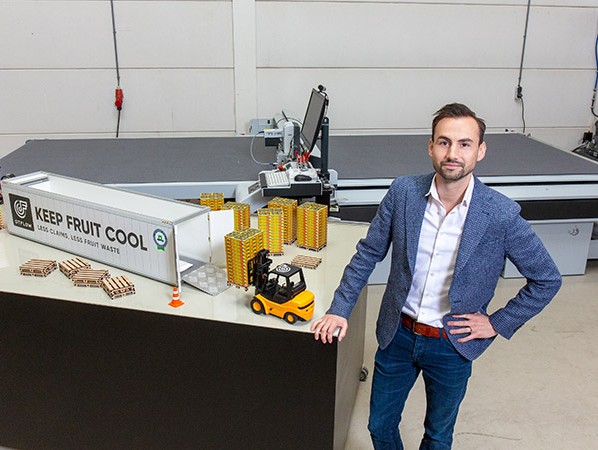
Great temperature differences in reefer containers cause many problems for fruit importers and exporters. Due to the difference in temperature, some of the fruit can no longer be sold and exporters receive many damage claims.
40% of the damage claims within the fruit trade are caused by temperature differences. Otto de Groot, founder of OTFLOW in Rotterdam, came up with the idea to cover the container floor and developed an air distribution mat together with Wageningen University & Research that reduces the temperature difference between the hottest and coldest location in the reefer container by 30%. Research by Wageningen University & Research has shown that the trapezoidal shape of the reefer mat is the most efficient floor covering for transporting pallets in refrigerated containers. This leads to fewer damage claims for fruit exporters and less food loss and waste for the fruit importer. Ronald Hagenstein was approached to put this revolutionary product onto the market.
Now that fruit is transported on pallets rather than in boxes, the air flow between the pallets escapes, causing so-called ‘hotspots’ due to outside heat. “The hotspots in a reefer container mainly emerge near the doors and are caused by factors like the ambient temperature – especially around the equator – and containers that are below deck”, Hagenstein, now co-owner, explains. “The first pallets with fruit are regularly thrown out because the quality is not good due to the temperature difference. Importers benefit from a homogenous product. Because our reefer mat creates an optimal air flow, the quality of the fruit the same throughout the entire container and food waste is prevented.
“I cut the first products by hand in a small shed together with Marc Reym, the third co-owner”, Hagenstein remembers. “The reefer mat initially consisted of one long piece that you could roll out into the container. This turned out to be very vulnerable, because the forklift would drive over the material with heavy pallets multiple times.
Marc, with his technical background, played an important part in the professionalism of the production. We now use an advanced machine that can produce dozens of mats per day. By hand, we could only make 6 in 8 hours. The product is installed modularly in the reefers. This makes the reefer mat suitable for all loading patterns and pallet sizes. Because it is intended for single use, we opted for recycled material from the food industry.”
The production of the reefer mats takes place in Hellevoetsluis; near the Port of Rotterdam, where the fruit arrives. According to Hagenstein, this is the perfect base: “Many of our customers, approximately fifty companies in the vegetable and fruit industry, are located in Westland and Barendrecht. Because we are close to the Port of Rotterdam, we can quickly see what the condition of imported fruit is.” He also sees opportunities for application with other goods. “We have been asked to apply the reefer mat to the transport of flower bulbs. We also see options for the transport of things like meat, dairy, fish, medicine and cosmetics. Even sneaker transport is interesting to us. Sneakers are increasingly transported with reefers because the glue lets loose at high temperatures.” The ambitions are great: expanding to multiple production locations across the world. “This will allows us to respond to the demand of our international customers even faster and better.”
Source: Rotterdam Food Cluster
Source: © Vakblad Voedingsindustrie 2019